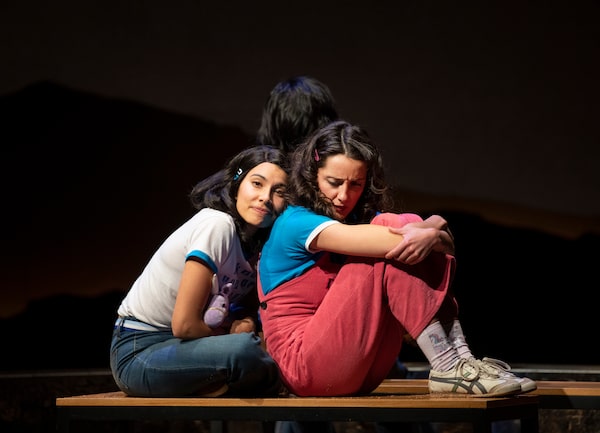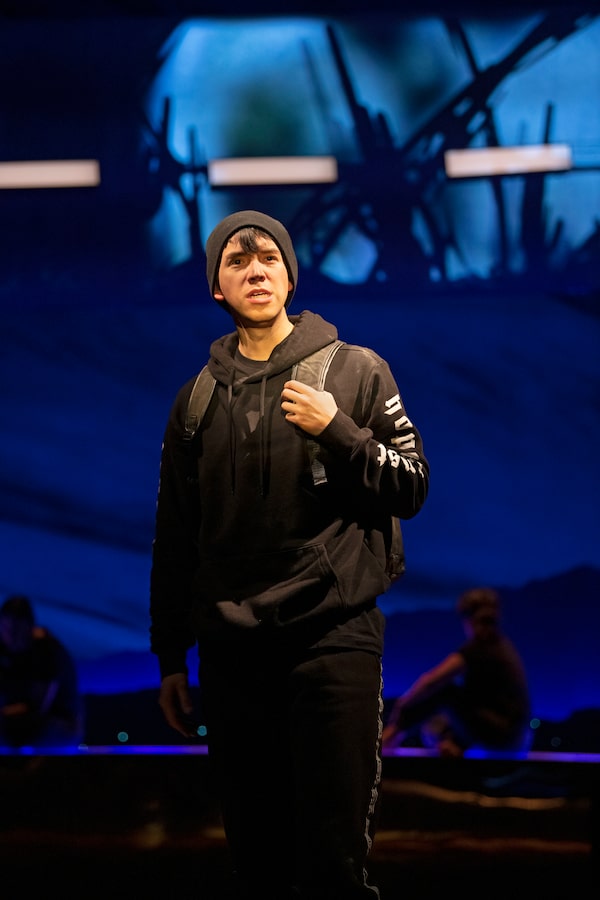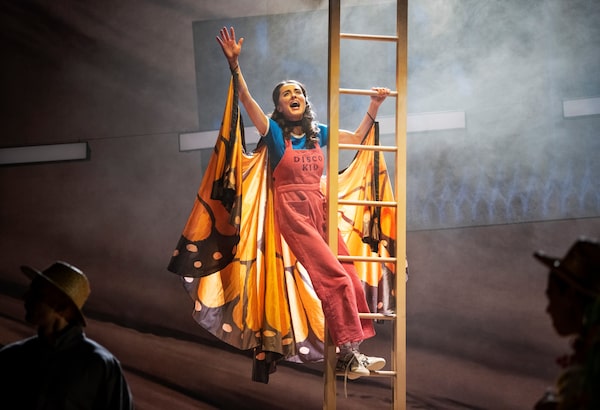
A.J. Simmons and Alexandra Lainfiesta in Anywhere But Here.EMILY COOPER
- Title: Anywhere But Here
- Written by: Carmen Aguirre
- Director: Juliette Carrillo
- Actors: Augusto Bitter, Alen Dominguez, Alexandra Lainfiesta, Shawn Lall, Nadeem Phillip, Christine Quintana, Michelle Rios, A.J. Simmons, Manuela Sosa
- Company: Electric Company Theatre (produced in association with Playwrights Theatre Centre and presented with the PuSh International Performing Arts Festival)
- Venue: Vancouver Playhouse
- Year: Until Feb. 15
In Anywhere But Here, which had its world premiere in Vancouver Thursday, the road to the border is paved with good intentions. Playwright Carmen Aguirre has an important story to tell – about the immigrant experience in Canada; the brutal Pinochet regime in Chile; the desperation that both leads to and accompanies migration; about the unnatural inhumanity of imposed borders – and especially walls. And about family dynamics in the midst of these suffocating external pressures.
But intentions do not a successful night at the theatre make. It is clear Aguirre has poured her heart and soul into this script. But Aguirre has a lot of heart and soul. And the result is a muddle.
In 1979, two Chilean-Canadian sisters (Alexandra Lainfiesta and A.J. Simmons), aged 11 and 12, are yanked from their comfortable life in Vancouver by their father (Nadeem Phillip), who is heartbroken after witnessing their mother (Christine Quintana) kissing another man. To add insult to Dad’s injury, Mom’s making out with a white guy, with as gringo a name as they come: Bill O’Neill.

Alen Dominguez in Anywhere But Here.EMILY COOPER
Dad puts the girls in the car and tells them they’re going home. But the home he’s thinking of is Chile.
The opening scene that sets the action in motion is a feast: a tableau that plays out in slow motion to that most 1970s of instrumental hits, Barry White’s Love’s Theme. It’s dramatic. It’s funny. And the set is gorgeous: a ladder to the sky reaches up from a sandy floor and a reddish rocky landscape. This is a desert in more ways than one.
During the endless drive south, the family, sans Mom, discusses the domestic dispute, Chilean politics, 1970s pop culture. Carolita, wearing pink overalls that spell out “Disco Kid” in a very ‘70s font, loves The Bionic Woman. Dad plays the Eagles and Paul McCartney and Wings on the car radio.
Their caught-between-two-cultures struggles are real. Carolita must work hard to remember anything from her young life in Chile. The country is a dangerous place for this revolutionary family, but it is also home in a way Canada can never be. Lupe wears a kilt in her dreams, but performs a Brazilian dance in it.
There is a lot to think about and look at. And the performances of the three road-trippers are terrific. In particular, Lainfiesta, who is from Guatemala and moved to Canada in 2010, is brilliant – note perfect as an 11-year-old.

Lainfiesta, who is from Guatemala and moved to Canada in 2010, is brilliant – note perfect as an 11-year-old.EMILY COOPER/Handout
But this production, like the family, goes south. As my companion for the night put it as we were leaving: it’s like somebody just threw a bunch of stuff in the blender.
The play unravels in threads that extend all over the place – in time, geography and approach – and few things seemed to stick. After a dramatic end to the first act, and an interesting opening to the second act, I was having trouble figuring out what exactly was happening. Audiences are smart; we don’t need everything spelled out for us. Magic realism is an effective dramatic tool. Challenging theatre is always welcome. Ghosts and butterflies can interact with live humans across decades and dimensions and it can work. But something that’s this hard to follow also becomes hard to care about.
Then there’s the rapping. At too few choice moments, an Aguirre-Shad Kabango rap co-creation would break out. I liked these a lot. But this did not happen frequently enough to avoid it feeling like a weird interruption. More rapping might have helped illuminate the themes – and amp up the entertainment. Because it was a long night – some two-and-a-half hours, including intermission.
This story is very personal for Aguirre, who says it has been in her brain for 30 years. She is a fine writer, and there are many fine moments in this script. Some big laughs, some big questions. “Does the leaving ever end?” one character asks.
The feat of the production itself is equally important – and historic: the program identifies it as is the “largest Latinx piece to receive its world premiere on a Canadian mainstage.” The implications are enormous.
And this is a meaningful story that cries out to be told. But at the end of the very long night, I couldn’t help but feel that the way this story is being told does it a disservice.

The play unravels in threads that extend all over the place – in time, geography and approach.EMILY COOPER
Live your best. We have a daily Life & Arts newsletter, providing you with our latest stories on health, travel, food and culture. Sign up today.
 Marsha Lederman
Marsha Lederman